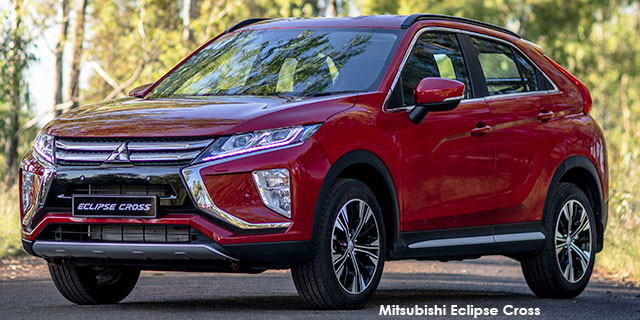
A fresh engine breathes new life into Mitsubishi’s quirky midsize crossover...
When we last tested a Mitsubishi Eclipse Cross, we praised the crossover’s unique styling, solidly built cabin and generally pleasant and refined road manners. However, we criticised Mitsubishi’s decision to offer a touchscreen infotainment system only as an option and decried the naturally aspirated 2,0-litre engine’s torque deficiency in a class consisting mainly of turbocharged rivals.
Fast-forward a year or so and Mitsubishi’s righted at least one of those wrongs blighting the original model. At the top of the range sits a new 1,5-litre turbopetrol engine. It’s coupled with an eight-step continuously variable transmission (CVT; two steps more than on the 2,0-litre) and is available in identical, feature-rich GLS specification.
The turbopetrol equipped with MIVEC (variable valve timing) – which is the sole forced-induction petrol powerplant in Mitsubishi’s local range of SUVs and bakkies – offers an impressive 110 kW at 5 500 r/min and 250 N.m on tap from 2 000 to 3 500 r/min. Mitsubishi claims it’s lighter than the 2,0-litre option (although our scales show the Turbo model to be a nominal 7 kg heavier), more efficient and quite a bit quicker in terms of acceleration, citing a 0-100 km/h time of 9,0 seconds.
Well, we had absolutely no issues matching that claim, recording a best three-figure sprint time of 8,96 seconds, placing it nearly three seconds ahead of the 2,0 GLS. To accelerate from 80-120 km/h, the 1,5 Turbo needs 7,13 seconds versus the NA engine’s 8,75. Be in no doubt, the new powerplant is brawnier and that’s most obvious at city speeds, where the turbo spools quickly, making the Eclipse Cross feel impressively sprightly in comparison with the lower-powered rivals at its price point.
This is another impressive CVT. We’ve long been critical of these transmissions but the newest versions – especially when they’re hooked up to torquey turbocharged engines – are much more appealing. In the Mitsubishi, thanks to the surfeit of twist at low revs, the CVT generally maintains engine speeds below 3 000 r/min. Swift overtaking or steep uphills will see the revs spike and the engine sounds strained. The 1,2-litre in the equivalent Toyota C-HR is a quieter companion. Still, this is a notable improvement on the 2,0-litre in terms of response, engine-transmission pairing and refinement. It’s worth mentioning it also consumed 0,2 L/100 km less on our combined-cycle fuel route.
Elsewhere, our compliments and criticisms remain. Styling-wise, the Eclipse Cross is a bold interpretation of the sub-niche of coupé-like crossovers with sloping rooflines and shallow glasshouses. Thankfully, in the case of the Mitsubishi, this does not come at the expense of interior passenger room. Headroom all-round is abundant and the rear bench slides by 200 mm to enable the owner to easily tailor occupant/luggage space. Only the split rear window affects visibility slightly.
Perceived quality is generally high, although the plastics that aren’t padded lower down on the facia and doors are a mite too shiny to really impress. Unfortunately – and unlike all of its natural rivals – the upgraded touchscreen infotainment system with Apple CarPlay, Android Auto and sat-nav remains an option at R14 375. The system is not the most user-friendly and, as such, we’d consider sticking to the standard touchscreen item if you don’t require screen-mirroring or native sat-nav. Bluetooth audio streaming will allow you to broadcast smartphone-app navigation instructions through the vehicle’s impressively punchy standard sound system.
It’s an odd omission if you consider the rest of the GLS grade’s strong specification. Items such as leather trim, LED lighting, head-up display, heating for the front seats, PDC front and rear coupled with an aft-facing camera and keyless entry and start are all standard. The Eclipse Cross also boasts a suite of active and passive safety features.
TEST SUMMARY
The Eclipse Cross is a prime example of the ability for a well-developed turbopetrol to enhance the driving experience. The 1,5-litre boosts the quirky crossover’s appeal and it morphs into a much stronger competitor in its class.
That said, if the new addition’s surfeit performance ability does not rank highly on your list of requirements, we’d consider the 2,0-litre at some R50 000 less or look further afield and test drive any number of other impressive options before making a decision.
ROAD TEST SCORE

|

|
Original article from Car









